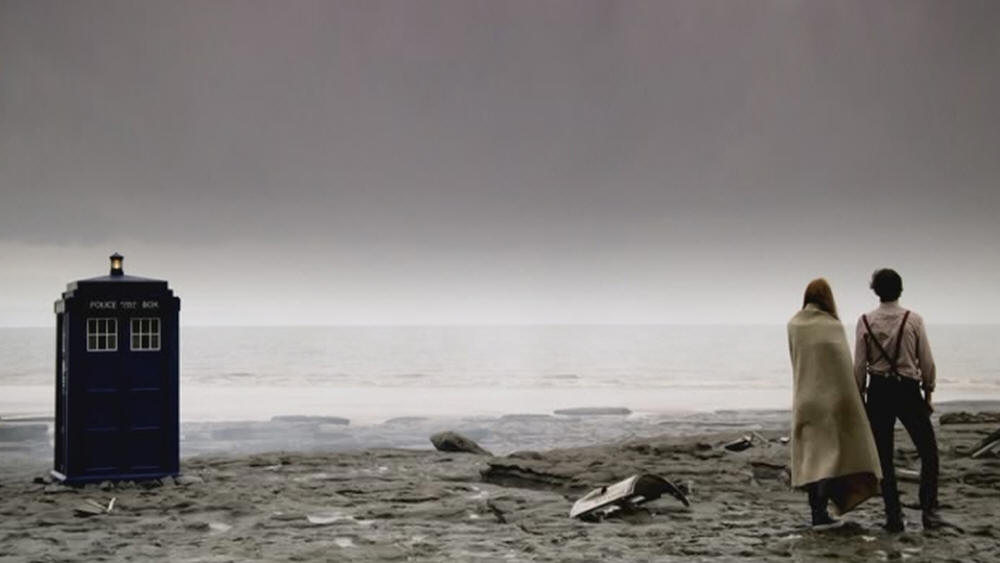
C+Q - Flesh and Stone (2010)

I'm a big fan of the way Series 5 handles its overarching
story. Episode 1 introduces the cracks in time and we find out
about the explosion that created them in Episode 12 and 13, but
Episode 5, 9, and to a lesser extent 6 gives us enough extra
information throughout the series to keep us interested. It
would've been way easier for them just to throw a crack into the
background of every episode like in The Beast Below, Victory of
the Daleks, or The Lodger, but instead the mystery is well paced
and provides us with enough details at regular intervals to keep
it at the forefront of our attention. After their complete
absence from The Time of Angels, Flesh and Stone deals with the
cracks in time heavily and even goes so far as to use them to
defeat the Weeping Angels at the end.
Looking at this episode retroactively after having seen the end
of the Matt Smith era, it's incredible how much of this story
stands up in hindsight and how much it's enhanced by being a
show about time travel with so many references to things that
haven't happened yet. Thing Number 1: the cracks in time. Not
only are their presence in this story a reference to the events
of The Pandorica Opens, but their creation is part of an attempt
by Madame Kovarian to stop the Doctor from reaching Trenzalore
in The Time of the Doctor. Thing Number 2: the jacketed Doctor.
I'm actually quite proud of myself for noticing on transmission
that the version of the Eleventh Doctor who comforts Amy in the
forest after the others have left is wearing his tweet jacket
when he wasn't a second ago. That's because this version is from
the future during the events of The Big Bang when he's rewinding
back through his own timeline. Thing Number 3: River Song. Like
with The Time of Angels, everything we see of River in this
story is consistent with who she turns out to be.
In the same way The Time of Angels explains the mechanics of the
Weeping Angels, Flesh and Stone cuts between the Doctor giving
the theory and Amy giving a practical demonstration to explain
the mechanics of the cracks in time. While the Doctor works out
in his head that time can be unwritten, Amy has to deal with the
soldiers who start to forget that their friends existed when
they walk into the light. There's also a pretty neat retconing
of the CyberKing from The Next Doctor which serves to clear up a
plot hole while making Matt Smith seem more like the Doctor by
having him remember something he did while he had David
Tennant's face. Nowadays, Smith is as much the Doctor to me as
Hartnell is, but back in 2010, I really needed convincing. Going
back and watching this episode made me realise how different he
looked between Series 5 and the rest of his tenure; his hair was
a lot darker and fluffier, his tweed jacket was genuine tweed
instead of the imitation he wore in Series 6 and 7, and he just
looked so much younger. It wasn't until A Christmas Carol that I
really saw him as being a 900-year-old Time Lord from Gallifrey.
One of the most controversial moments of this episode is when we
actually see the Weeping Angels move. While I loved Hettie
MacDonald's direction in Blink and the idea that the camera was
like a character, stopping the Angels from moving when the
characters couldn't see them, I personally don't mind seeing
them move. It's such a chilling moment and for the production
team it must have been completely irresistible. The best way to
bring back old enemies to have them doing things we didn't see
them do the first time around, so to get a Weeping Angel
visually moving in a Blink sequel was almost inevitable. It's
definitely a cool effect and the sound design really sold the
idea that these were solid statues moving around.
I'd call the Angels moving the most controversial moment
outright if it weren't for the ending, in which Amy Pond takes
the Doctor back to her bedroom and straight-up tries to fuck
him. Here we see an important stage in Amy's arc as a character.
She starts off trying to fuck some guy on the night before her
wedding, and ends up sacrifices travelling all of time and space
just so she can be with her husband. I really don't think Moffat
gets enough credit for how amazingly well-handled Amy is.
Instead, her erratic and spontaneous behaviour (like the fact
she has had five canonical jobs in two and a half series) is put
down to being a product of inconsistent writing rather than
being a part of who she is as a character (I myself have been
guilty of making that mistake). The story of Amelia Pond is
about a girl who learns the harsh truth that life is not a
fairytale and that we all need to grow up some day, and it's
beautifully told.
I really love this two-parter, not only as a self-contained
piece of fiction but for its contribution to the overall story
of Doctor Who. It makes many meaningful additions to the lore,
including new powers for the Weeping Angels, new details about
River's backstory, and a partial explanation for the cracks in
time. The existence of these two episodes mean that "the crash
of the Byzantium" mentioned as a throwaway line in River Song's
diary now has an entire adventure associated with it. This whole
story is just one big continuity-fest and I love it.
Next: The Vampires of Venice